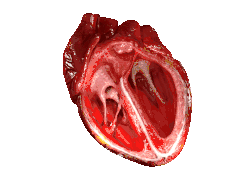Heart valve
A heart valve normally allows blood to flow in only one direction through the heart.
| Heart valves | |
|---|---|
 Valves of the heart in motion, the front wall of the heart is removed in this image. | |
| Details | |
| System | Cardiovascular |
| Identifiers | |
| MeSH | D006351 |
| FMA | 7110 |
| Anatomical terminology | |
The four valves are commonly represented in a mammalian heart that determines the pathway of blood flow through the heart.
A heart valve opens or closes incumbent on differential blood pressure on each side.[1][2][3]
References
- "Heart Valves". American Heart Association, Inc – 10000056 Heart and Stroke Encyclopedia. American Heart Association, Inc. Retrieved 2010-08-05.
- Klabunde, RE (2009-07-02). "Pressure Gradients". Cardiovascular Physiology Concepts. Richard E. Klabunde. Retrieved 2010-08-06.
- Klabunde, RE (2007-04-05). "Cardiac Valve Disease". Cardiovascular Physiology Concepts. Richard E. Klabunde. Retrieved 2010-08-06.
This article is issued from Wikipedia. The text is licensed under Creative Commons - Attribution - Sharealike. Additional terms may apply for the media files.